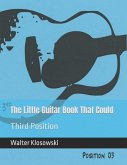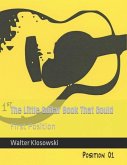This LITTLE GUITAR BOOK THAT COULD is the inaugural volume in the FRETBOARD COLLECTIONS SERIES. It collects and subsequently showcases the C A G E D guitar chords and scales found in the FIRST, SECOND, THIRD and FOURTH POSITIONS for all to see, use and reference. But, before thumbing through this book, there is some practical subject matter that the guitarist may need reminding of...even though he or she may have played for years. For example, in this book, six is the exact number of consecutive frets involved in said random guitar position and it spans a full two octaves plus a perfect fourth when in standard tuning. Also when in said random position the second and third fingers on the fretting hand are to remain stationary in their respective frets or "slots", initially, as their stationary qualities allow the first and or fourth finger to stretch or slide that additional fret. Conversely, for the picking hand, know that a very useful picking pattern occurs down by the sound hole or bridge where that hand happens to be a majority of the time. This pattern involves every other string and is best evidenced when the C A G E D main root note sequence is plucked alphabetically, starting with the root on the first or thinnest guitar string. Start by picking the given root note as showcased in the specific chapter, located on the first string. Then pick the root note found on the third string, then the fifth, then second, then fourth and finally conclude with the root note on the sixth string. The one-three-five-two-four-six string pattern naturally fits the finger picking style and is looped, forwards or backwards (six-four-two-five-three-one) as the root notes found on the first/sixth string(s) are deemed interchangeable. There are also three musical terms that need brief clarification for the purposes of this collected volume of THE LITTLE GUITAR BOOK THAT COULD...those being main root notes, octaves and unisons. What are main root notes? Generally speaking, main root notes represent a specific set of root notes that fall beneath or cluster together under the second and third fingers of the fretting hand when in a guitar position, although there are two instances where the first and fourth fingers are involved. Still, once the location of each main root note is learned in the position, the attention then moves to their octaves, which is defined as the interval between one musical pitch and another with half or double its own frequency. Some correctly call the interval a "perfect octave", and in guitarland, octaves are usually "one string one fret away" on the fretboard. This handy guitar fact helps memorize their location even though, occasionally, two strings and or two frets are involved (the same concept applies in that there will be some sort of string skipping involved.) And lastly, unisons are defined as when two or more music notes happen to sound the same pitch. In guitarland, it usually means "same note different string or fret". The term also implies that the unison occurs in the guitar position at hand. And that's it! This LITTLE GUITAR BOOK THAT COULD for the FIRST, SECOND, THIRD and FOURTH positions is collected and presented for the first time ever in one handy single volume. VOLUME ONE here is uncomplicated, straightforward, and very easy to use due to its "picture worth a thousand words" visual based format allowing one to take full advantage of the guitar fretboard material straight away. You'll have fun discovering some fresh perspectives on the same old same old, while also adding some new twists and turns to your own technique. As always, thank you very kindly for choosing this volume, volume one, from the collection to include in your library of fretboard knowledge needs...Enjoy!
Hinweis: Dieser Artikel kann nur an eine deutsche Lieferadresse ausgeliefert werden.
Hinweis: Dieser Artikel kann nur an eine deutsche Lieferadresse ausgeliefert werden.








